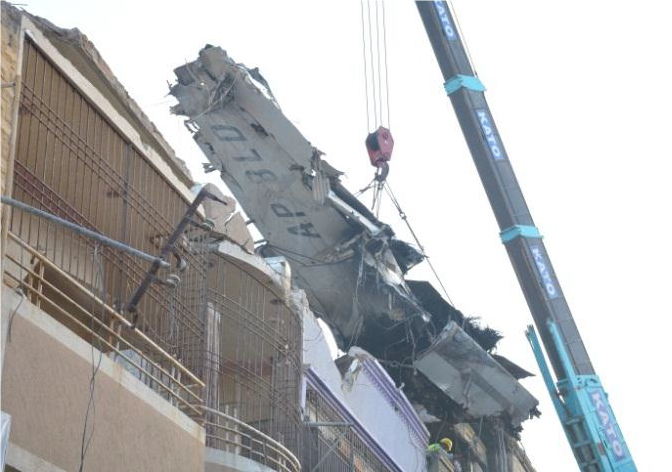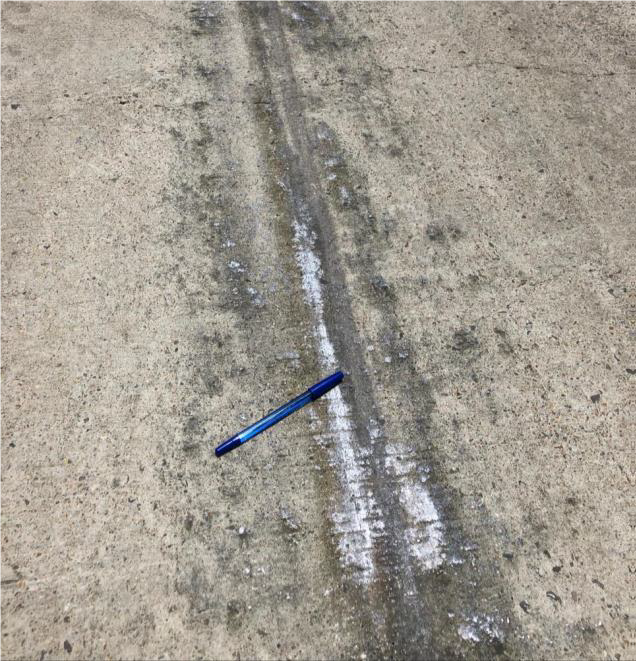- The 2020 Fatal accident was third most catastrophic aviation disaster in Pakistan's history.
- Final Report highlights poor communication between pilots and air traffic controllers.
- The Pakistan International Airlines Airbus A320 aircraft attempted landing without opening landing gears.
A Pakistan International Airlines plane crash that killed 101 people near the Jinnah International Airport here in May 2020 was a result of 'human error' by the two pilots, according to the final investigation report released by the Aircraft Accident Investigation Board.
The final report sheds light on the causes behind the tragic crash of Pakistan International Airline's (PIA) Airbus A320 nearly four years ago in Karachi. On May 22, 2020, the ill-fated PIA flight PK 8303 flew from Lahore to Karachi on the afternoon of Friday in Ramadan, with 99 people including passengers and crew on board.
97 people were killed in the accident, two passengers miraculously survived. Two people were also killed on the ground when the plane fell on the population in Karachi’s Model Town area.
A conclusion after a detailed investigation on different angles related to the flight that day, the report attributes the disaster, which resulted in the loss of at least 99 lives on May 22, 2020, to "human error."

At least 99 people including passengers, crew and two area residents on which the plane crashed died in the tragic accident, now being identified as the third most catastrophic aviation disaster in Pakistan's history, claimed the lives of passengers, crew members, and two local residents near the crash site.
Among the grim statistics, only two individuals, the then chief executive of the Bank of Punjab and a young engineer, survived the crash.
Several houses in the neighbourhood and parked vehicles were destroyed and damaged in the disaster. The report said the air traffic controller had four times warned the pilots that they shouldn’t land as their altitude was not right.

According to the report, when the pilots first tried to land the aircraft, its engines hit the ground, which led to the system supplying lubricant to the engines shutting down. The report said that “engine failure” eventually led to the crash.
Some parts recovered from the runway 25L were identified as CFM56-5B engine and A320 nacelle parts, consistent with the CCTV videos of the airport showing the lower part of the nacelle and engines impacting the runway during the first landing attempt.
The report revealed that the pilot was warned four times by the air traffic controller before landing that the plane was at extraordinary altitude, however the fifth time the traffic controller allowed the plane’s landing. The findings say that there was a lack of communication and harmony between the two pilots and air traffic controllers.
“During the aircraft’s first landing, the two pilots were not focused. Making approach for the first landing, the airplane’s landing gears were opened, however right at the landing time one of the pilots again closed the landing gear. Hence, the plane made an attempt for landing without opening the landing gears for the first time, during which its engines struck the runway which ignited flames,” the report said adding that the air traffic controller did not inform the pilots about the engine’s striking the ground and emitting flames.
Both the engines were affected due to this. The system that provides lubricant oil to both engines had gone out of order after the engine thudded the runway. Following this both the engines stopped at the same time.

The crash site was located in a residential area northeast of JIAP. The wreckage lies approximately 1340 m from the runway 25L threshold close to the extended runway centerline. The aircraft parts were spread out over 75 m in a single street, with some parts on the roof tops of adjoining houses.
The findings revealed that data from the plane’s last four minutes could not be recorded as engine failure cut the electricity supply. The report has levelled the administrative responsibility for the accident on the PIA and Pakistan Civil Aviation Authority as well.
The report mentioned that rules of the Civil Aviation Authority regarding the pilots’ flying plane while fasting were not evident.
“Flight data analysis after every flight in the PIA is not being followed by the FDA. Due to a lack of flight data analysis, mistakes of pilots related to flight procedures are not revealed. Because of this attention is not paid to correcting these mistakes,” the report concluded.
What happened on that day ?
- On 22 May 2020 PIA flight PK8303 took off from AIIAP Lahore at 13:05 hrs (as per the Lahore ATC recording / transcript). Departure from Lahore and cruising flight were uneventful.The crew did not follow standard callouts and did not observe CRM aspects during most parts of flight.
- “Area Control Karachi East” cleared PK8303 for “Nawabshah 2A” arrival procedure (STAR - Standard Terminal Arrival Route as published in AIP and JEPPESEN), and advised to expect ILS approach for runway 25L. The flight was later cleared at pilot’s discretion to report direct MAKLI (a waypoint 15 nautical miles at a radial of 075 from Karachi VOR) and descend to FL100, and later re-cleared for FL50. The aircraft changed over to “Karachi Approach” and was cleared to descend down further to 3000 ft, by the time it reaches MAKLI.
- The aircraft ended up higher than the required descend profile. At MAKLI the aircraft was at 9780 ft and at about 245 knots IAS. In order to manage the descent and lose the additional height, “OPEN DES” mode was selected via the FCU, both autopilots were disengaged and speed brakes were extended.
- “Karachi Approach” inquired “confirm track mile comfortable for descend” and later advised to take an orbit, so that the aircraft can be adjusted on the required descend profile. No orbit was executed and the effort to intercept the glide slope and localizer (of ILS) was continued. The FDR indicated action of lowering of the landing gears at 7221 ft at around 10.5 Nautical Miles from Runway 25L.
- “Karachi Approach” advised repeatedly (twice to discontinue the approach and once cautioned) about excessive height. Landing approach was not discontinued. However, FDR shows action of raising of the landing gears at 1740 ft followed by retraction of the speed brakes (at a distance slightly less than 05 nautical miles from the runway 25L). At this time, the aircraft had intercepted the localizer as well as the glide slope. Flaps 1 were selected at 243 knots IAS, the landing gears and speed brakes were retracted. Over-speed and EGPWS warnings were then triggered.
- Since the approach to land was continued, “Karachi Approach” instead of changing over the aircraft to “Aerodrome Control”, sought telephonic landing clearance from the “Aerodrome Control”. The “Aerodrome Control” conveyed a landing clearance of the aircraft (without observing the abnormality that the landing gears were not extended) to “Karachi Approach”. Subsequently “Karachi Approach” cleared the aircraft to land.
- At 500 ft, the FDR indicates: landing gear retracted, slat/flap configuration 3, airspeed 220 knots IAS, descent rate 2000 ft/min. According to the FDR and CVR recordings several warnings and alerts such as over-speed, landing gear not down and ground proximity alerts were disregarded. The landing was undertaken with landing gears retracted. The aircraft touched the runway surface on its engines.
- Flight crew applied reverse engine power and initiated a braking action. Both engines scrubbed the runway at various locations causing damage to both of them.

- The “Aerodrome Control” observed the scrubbing of engines with the runway but did not covey this abnormality to the aircraft. It was conveyed to the “Karachi Approach” on telephone. Subsequently “Karachi Approach” also did not relay this abnormality to the aircraft.
- The landing was discontinued and a go-around was executed. FDR recording indicates a brief action of selection of landing gear lever to down position, which was immediately followed by its movement to up position. Intention to undertake another ILS approach for landing on runway 25L was conveyed, however shortly after the go-around both engines failed one by one. Ram Air Turbine (RAT) was deployed to power the essential systems. FDR data recording stopped during this timeframe (as per the designed limitation). The aircraft was unable to maintain required height. The aircrew declared the emergency situation that both engines were lost, and transmitted a “Mayday Call”. Evidences from the wreckage indicate reasons for right engine failure, however left engine requires further examination, and landing gear in extended position did not demonstrate any malfunction of the landing gear system.
- The aircraft crashed about 1340 meters short from runway 25L. It was a slow speed impact with high angle of attack, with aircraft configuration indicating landing gears extended, slats at step / position 1, and flaps retracted. The said configuration was ascertained and documented from the wreckage at the crash site (as the FDR data recording had stopped earlier).
- The aircraft was reportedly serviceable for the said flight; and the Captain and First Officer were adequately qualified and experienced to undertake the said flight; necessary scrutiny of the aircrew records / documents was done.
Picture and information Source : caapakistan.com.pk
More news on Pakistan Aviation......








